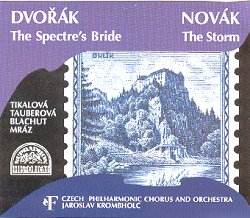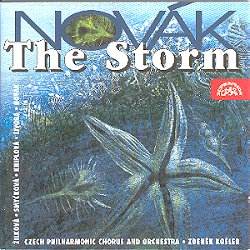Vítezslav NOVÁK's
The Storm
A Feature Review of two Supraphon CDs: (1) Krombholc,
1956; (2) Kosler, 1978.
|
Antonín DVORÁK
(1841-1904)
The Spectre's Bride (1885) [83.50]
Vítezslav NOVÁK
(1870-1949)
The Storm - A Sea Fantasy on words by Svatopluk Cech for soloists,
mixed chorus and large orchestra (1910) [70.40]
 Dvorák:
Dvorák:
Drahomírá Tikalová (sop) (Maiden)
Beno Blachut (ten) (Spectre)
Ladislav Mráz (bass-bar) (Story-teller)
Czech Philharmonic Chorus/Josef Veselka
Czech Philharmonic Orchestra/Jaroslav Krombholc
Novák:
Drahomíra Tikalová (sop)
Maria Tauberová (sop)
Beno Blachut (ten) (Spectre)
Ladislav Mráz (bass-bar) (Story-teller)
Vladimír Jedenáctik (bass)
Jaroslav Veverka (bass)
Czech Philharmonic Chorus/Jan Kühn
Czech Philharmonic Orchestra/Jaroslav Krombholc
Dvorák: rec Rudolfinum, Prague,
25-27 Mar, 4-5 Apr 1961
Novák: rec Rudolfinum, Prague,
7-10, 12, 20 Nov 1956
 SUPRAPHON 11 1982-2 212
2CD Stereo (Dvorak) Mono (Novák) AAD [CD1: 76.40; CD2:
77.56] SUPRAPHON 11 1982-2 212
2CD Stereo (Dvorak) Mono (Novák) AAD [CD1: 76.40; CD2:
77.56]
Crotchet
AmazonUK AmazonUS |
Vítezslav NOVÁK
(1870-1949)
The Storm - A Sea Fantasy on words by Svatopluk Cech for soloists,
mixed chorus and large orchestra (1910)
 Jarmila Zilková
(sop) Jarmila Zilková
(sop)
Jarmila Smyczková (sop)
Frantisek Livora (ten)
Nadezhda Kniplová (sop)
Richard Novák (bass)
Kvetoslava Nemecková (sop)
Karel Petr (bass)
Jaromir Vavruska (bass)
Czech Philharmonic Chorus/Josef Veselka
Czech Philharmonic Orchestra/Zdenek Kosler
rec Dvorák Hall, Rudolfinum, Prague 6-12 Dec 1978 AAD
 SUPRAPHON SU 3088-2 211
[76.05] SUPRAPHON SU 3088-2 211
[76.05]
Crotchet
AmazonUK AmazonUS |
 |
 |
While the motivating spark for this feature is the Novák work I do
not dismiss the Dvorák from comment. How could I? Quite apart from
taking up the whole of CD1 in the Krombholc set and 6 minutes of CD2 it is
a most surprising work. It terms itself a 'Dramatic Cantata' so we are ready
for the secular Dvorák. What I was unprepared for was the operatic
treatment.
Rather like Tchaikovsky, Dvorák cherished the dream of producing a
great opera. Like Tchaikovsky the Czech composer's fame stands firmly on
anything but his operas. In fairness Tchaikovsky achieved more in the operatic
sphere in Eugene Onegin though I have a high regard for Iolanta
too. Dvorak had his Rusalka and at least one bonne-bouche aria
from this but neither the Czech nor the Russian are seen as primarily operatic
composers.
For Krombholc, Tikalová, Blachut and Mráz are in good form
though Blachut does show strain in his duets with Tikalová. There
is strength in these voices though there is less attention to dynamic variety
than I would have hoped. The singing often has an imposing 'Russian' quality
(track 12 CD1) which, at this remove in time, may be cheerfully accepted
as a strength but must have been received ambiguously at the time of the
sessions.
The 'Bride' story is by the Czech poet, Karel Jaromir Erben (1811-1870) whose
gruesome stories also provided the impetus for Dvorák's late tone
poems (e.g. The Water Goblin, The Noonday Witch and The
Golden Spinning Wheel). The Spectre's Bride portrays the macabre
element far better than the tone poems. The story tells of a nocturnal
horror-haunted flight into Doom. The tradition tapped into is an ancient
one and is also picked up in the stories by Grimm and Andersen and in Albrecht
Dürer's woodcuts. The story involves the widowed young bride calling
back her dead beloved from death (shades of Orpheus, Savitri
and Gilgamesh), being punished for her blasphemy and saving herself
in repentance. The Dvorák is very varied and rich in melodic incident
and orchestral effect. Yes, there are the standard Dvorák fingerprints
but, in addition, there is a Beethovenian storminess. Well worth you ear-time.
Let's leave Krombholc for a short while and move to the Kosler disc of the
Novák work.
The Storm (in Czech Boure) is based on a poem - 'a sea fantasy'
- by Svatopluk Cech. The poem had already been set or intended for setting
by Josef Foerster, by Fibich and by Frantisek Neumann. Seven of the fifteen
movements are for orchestra alone. The treatment is from the most mature
tide-line of late romanticism. Think in terms of Bantock, d'Indy, Alfvén,
Zemlinsky, Schmitt, Schreker and Suk. The whole thing is a quite masterly
example of the secular cantata and its approximate alternation of tesella,
vocal with orchestra and orchestra alone, works astonishingly well.
The Storm was premiered in Brno on 17 April 1910 and performances
followed at Pardubice and Chrudim in 1911, Prague in 1912 and Vienna in 1913.
Unlike The Spectre's Bride and other choral works by Dvorak The
Storm had little or no currency outside the European mainland. Novák
had poured a great deal of himself into this major work. Two years of work
were invested in creating this great fresco of symphonic design and consummation.
In it he forsook the Mediterranean sea-images of the Eternal Longing for
the colder climes of Northern seas. Still, the piece is less about portrayal
of the sea and more wrapped up in the imagery of the ocean and its role as
the source of death and renewal. The sea and storm is also bound up with
the eroticism reflected in the duet with the Sudanese prince. This is also
apparent from storm-lofted dramatic cry of Nadezhda Kniplová in the
Kosler version and of Drahomira Tikalová for Krombholc in track 12.
Kniplová is splendid and expresses more of the sensuous element than
Tikalová.
The horns and trombones have an apt hoarseness in the older Krombholc session;
just the same throaty quality you find in Talich's Asrael recording
from roughly the same vintage. Listen to the burred abrasion in track 3 at
2.30. Krombholc also makes more of the horn choir in the prelude and its
echoes of Borodin's Prince Igor Overture. In general Krombholc is
not so well served in his singing team as Kosler who has attracted a cult
following for his recordings of the later Dvorák symphonies. The 1950s
Czech line up have a tendency to Slavonic wobble which can be well heard
in track 8. However in the impassioned duet at track 11 Mráz is
golden-toned and his heated 'colliding' dialogue with the soprano has the
manic edge of Strauss's Elektra.
Kosler is superior. While both sets are AAD rather than ADD the
reach-out-and-touch technical quality of the 1970s Kosler is a joy. The stereo
also helps. The dramatic screaming fanfare of the opening bars is scorchingly
abrasive, heaven-screeching, bloodied and defiant. That fanfare is a leitmotif
that will recur and help bind the work into a symphonically rounded whole
though I confess that the penultimate shore scene does not quite convince.
Other motifs are also used and this whole approach follows that in Bantock's
supreme masterpiece (unrecorded, I am afraid), Omar Khayyam - a work
contemporary with the Novák. Those fanfares return in track 3 and
also, much later, to mark the crash of the ship's mast at the height of the
storm. The male chorus catch rather well the grotesquerie of the music and
the dwarf song is delivered with incisive choral unanimity and definition.
No doubt this was down to Veselka's sedulous coaching. The singing has a
screaming rush - part triumph and part foreboding. If you love the black-sound
achieved by Finnish male voice choirs in Kullervo you'll like this.
The Sibelius of the threatening bass-heavy Tuonela is also apparent in the
deep rushes and rumbles of the orchestra in the Tempestoso movement
just after the love duet.
Novák also shows that he knew his Smetana. In track 5 the bubbling
woodwind is a different take on the surging current of Vltava. Over
this Jarmila Smyckova sings a wonderful melisma devastating and stratospheric
and paced less hysterically than her counterpart in the Krombholc. That folk-like
vocalise rather parallels Canteloube; all of which reminds me that Douglas
Bostock's latest instalment in the ClassicO sequence of Novák song
cycles (with orchestra) has only just been issued. The Vltava springs
return in bass-accented echo in the Moderato (track 10) as does that
defiant and excoriating fanfare. Listen also however to Krombholc's Czech-toned
trumpets at 4.42 in track 14 - just that shading of vibrato. The wonderful
French horn winds down into silence as in the enchanted epilogue of Bax's
Sixth Symphony. While there is real orchestral character in Krombholc's Czech
Phil, the same orchestra remains untainted in Kosler's hands with the additional
advantage of a very strongly projected stereo image.
In Kosler's Andante (7) Frantisek Livora as the Youth under the Mast
sings with the same unforced and admirably steady muscularity as Smycková.
The glorious tone of the choir keeps recalling, in its sturdy effect, Delius's
A Mass of Life. This is not the last time we will think of Delius
either. In the final tableau the quietly sung reflection of the mixed chorus
takes us, most aptly, into Sea Drift territory or indeed into the
Morning section of the Delius Mass. Amid the Delian echoes Novák's
writing is touched also with the expressionism of Schoenberg's
Gurrelieder. There is respite though. The andante rubato
is Tchaikovskian in its gentle dialogue of strings and woodwind and there
are many other instrumental highlights including the probing and striving
high violins at 5.30 in the andante rubato.
Richard Novak projects nostalgic strength as the exiled Sudanese king reminisces
in the ship's cabin. Novak lacks the generous chocolate tone of Ladislav
Mráz (for Krombholc) though there is a quaver in Mráz's voice
which I did not hear in his Dvorák. His serenading, almost Neapolitan,
singing of Spi, má mladá (Sleep my young one) is unmatched
by Richard Novak. One can almost imagine Gigli in this role.
When the Kosler was first released I recall the Gramophone critic comparing
the Kosler unfavourably with the Krombholc. For the reasons I have given,
and overwhelmingly because of Kosler's team of solo singers I commend the
single disc Kosler version. It is not as if the Krombholc is poor. I have
already alerted you to only a fraction of its strengths but its rushed approach
in at least two places and the quality (some would say the authentic quality)
of the solo singing place it below Kosler. As for whether or not you will
like the music all I can say is that if the crude parallels I have drawn
above are at all part of your listening repertoire then you must hear The
Storm. For those who have already discovered Novák through the
Pesek-conducted Chandos orchestral collection or through the much less celebrated
Bostock ClassicO series this also is the disc for you.
Rob Barnett
WEB-SITE
http://www.kapralova.org/NOVAK.htm

